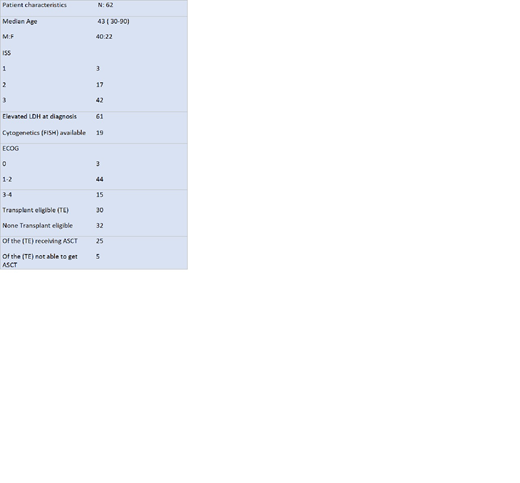First Review of Multiple Myeloma patients in Sheikh Khalifa Medical City, Abu Dhabi, United Arab Emirates.
Introduction
Multiple Myeloma (MM) accounts for approximately 1 to 2 percent of all cancers and slightly more than 17 percent of hematologic malignancies in the United States (1). The annual incidence in the United States is approximately 4 to 5 per 100,000(2). A similar incidence has been reported in Canada, the South Thames area of the United Kingdom, and in Europe in general. Worldwide, there are approximately 160,000 cases and 106,000 deaths per year attributed to MM (3).MM occurs in all races and all geographic locations. The incidence varies by ethnicity; the incidence in African Americans and Blacks from Africa is two to three times that in Whites (4).
Here we report the first study in Abu Dhabi, United Arab Emirates done on MM patients in our institution Sheikh Khalifa Medical City.
Methods
We did retrospective analysis of patients diagnosed with multiple myeloma from year 2016-2018 in our tertiary care institution Sheikh Khalifa Medical City in Abu Dhabi, United Arab Emirates.
Total number of patients admitted with ICD 10 diagnoses containing multiple myeloma from 2016 to 2018 were 1582. Out of these we included 62 patients with confirmed multiple myeloma and excluded others.
Results
Total number of patients were 62 (40 males, 22 females). Median age was 43 years (range 30 to 90 years). Multiple myeloma International staging score (ISS) for our patients was stage 1 (n=3), stage 2(n=17) and stage 3(n=42). Eastern Cooperative Oncology Group Performance Score (ECOG) in MM patients was grade 0(n=3), grade 1(n=33), grade 2(n=11), grade 3(n=12) and grade 4(n=3). LDH was high in 61 patients and normal in 1 patient. 30 patients of 62 were Bone Marrow Transplant (BMT) eligible. 25 of 30 eligible transplant patients had Autologous stem cell transplant (ASCT). 41 patients till date are, 18 have died and status of 3 is unknown. 22 of 25 transplanted patients are alive till current date, 2 have died and status of 1 is unknown.
Cytogenetics stratification was not possible due to lack of access to Fluorescence in situ hybridization (FISH).
Discussion
The male to female ratio for MM patients was approximately 2:1. In our population we noticed that majority of the patients (n=42) presented as ISS stage 3 which indicates poor prognosis. The ECOG performance score of stage 1 was for 33 which is approximately 50% for total MM patients. This indicates that most of our MM patients were in good functional status at time of diagnosis. LDH was high in 61 patients.
We do not have hemopoietic stem cell transplant service in UAE hence this put pressure on patients and their physicians to push for it. BMT eligible patients were 30. 25 out of 30 patients had ASCT and 5 couldn't do it due to financial and other reasons. Of the ASCT patients (n=25), 22 are alive till date, 2 have passed away and status of 1 is unknown. The success of ASCT is almost 90% in our MM patients. We could not calculate the progression free survival of our patients as the follow up period was short. Out of our 41 alive patients till date, 22 are the ones who had ASCT.
In the next phase of our study we plan to calculate 5 year progression free survival for our MM patients.
Conclusion
With the resources available tough cytogenetics and FISH not available easily and no HSCT service, we concluded that the MM patients in our population have higher ISS scores which indicates poor prognosis. However we believe for if we manage to do ASCT for our MM patients we would have excellent survival outcomes.
This puts more incentive to open HSCT service and especially ASCT.
No relevant conflicts of interest to declare.
Author notes
Asterisk with author names denotes non-ASH members.


